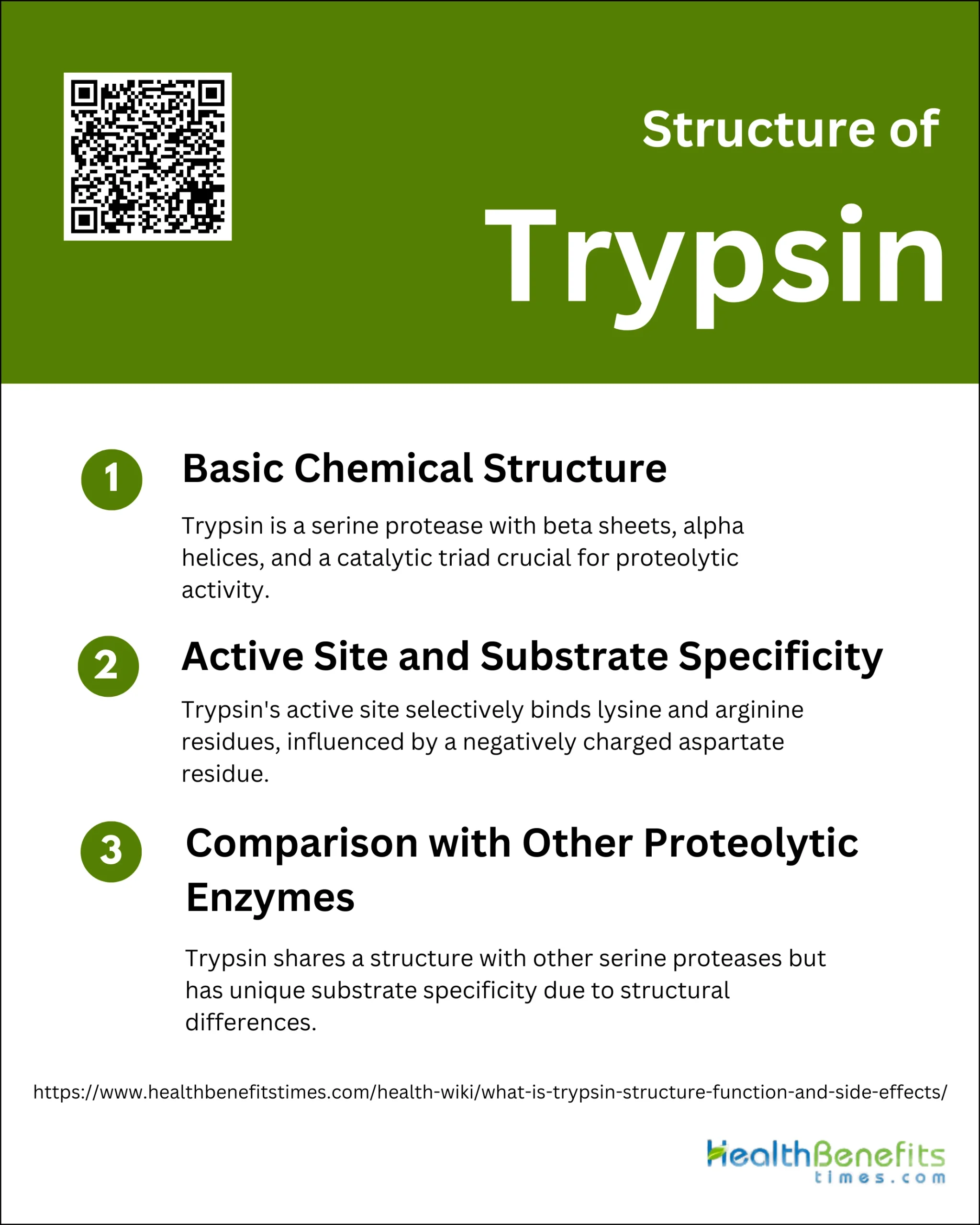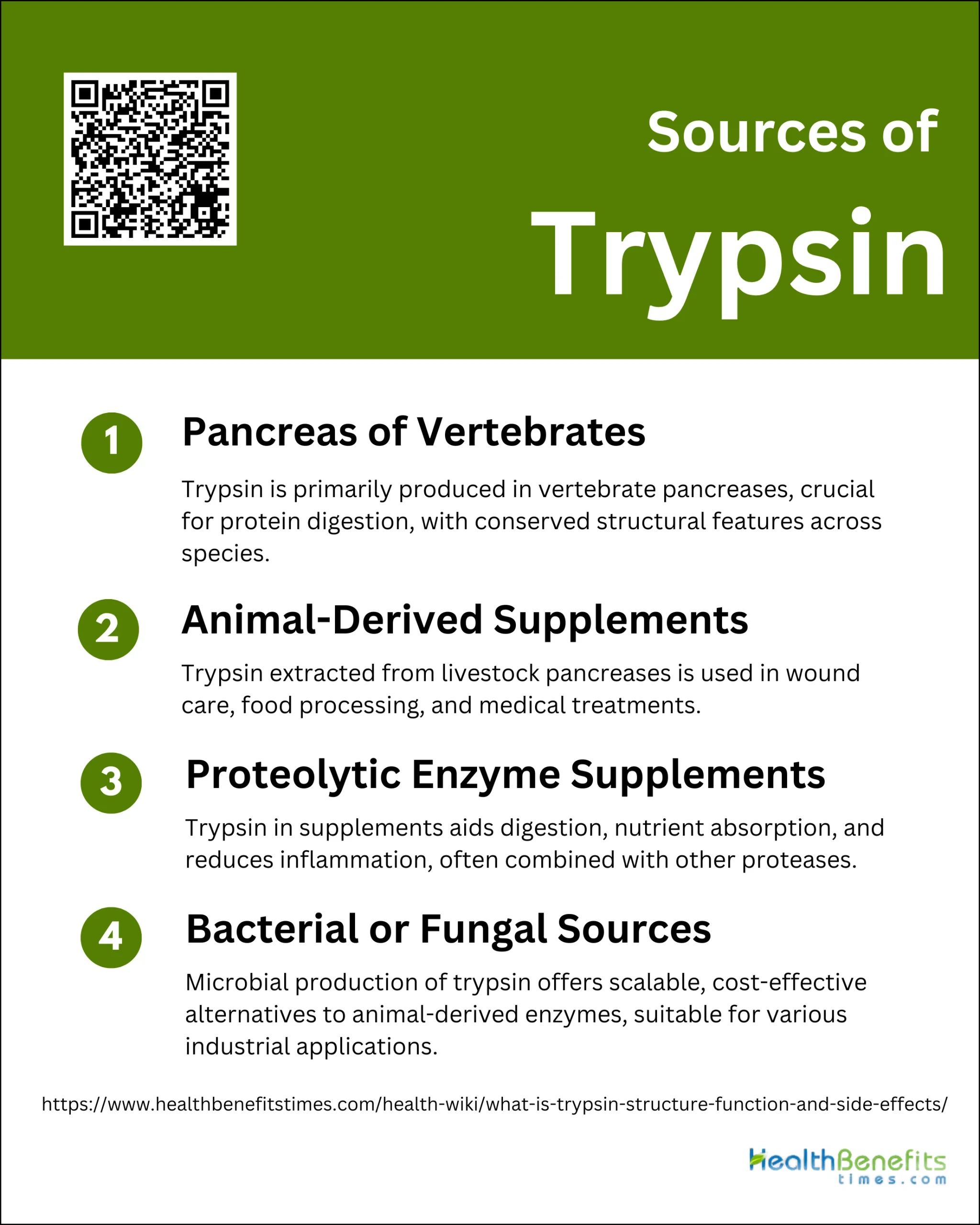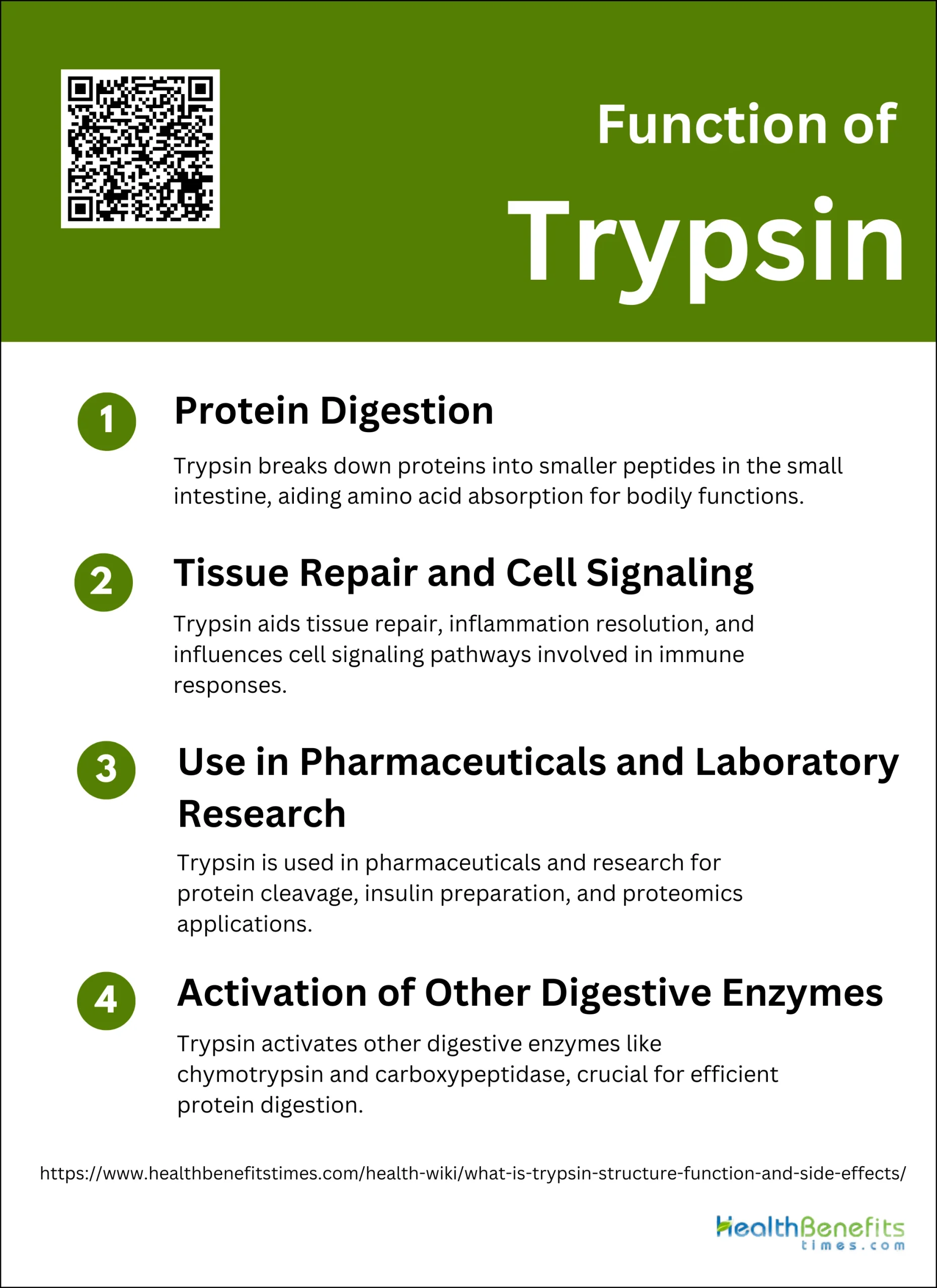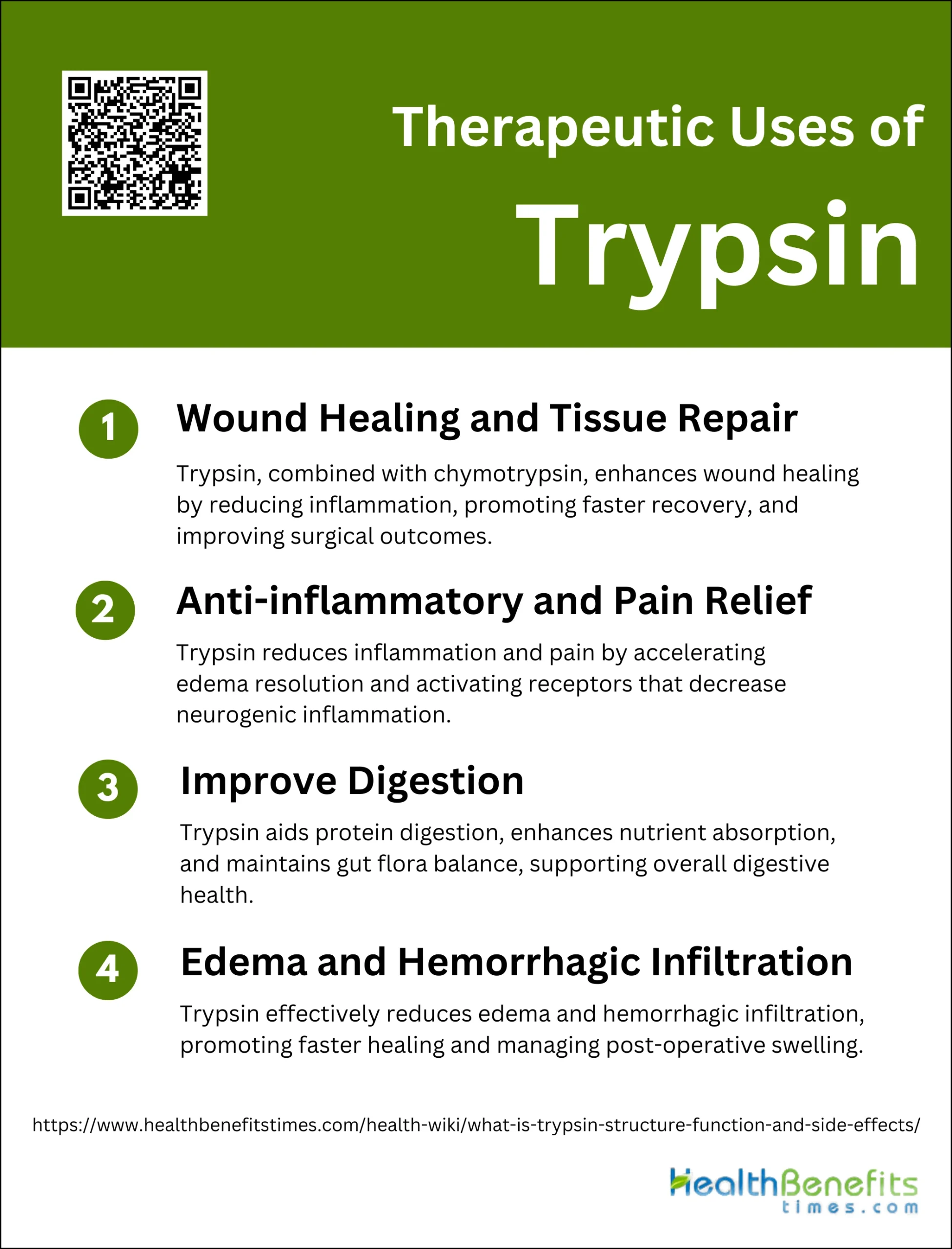 Trypsin is a serine protease enzyme that plays a crucial role in the digestive system by breaking down proteins into peptides. It is highly specific in its action, cleaving peptide bonds exclusively at the carboxyl side of the amino acids arginine and lysine. This specificity makes trypsin an invaluable tool in mass spectrometry-based proteomics for converting complex protein mixtures into simpler peptide populations for analysis. Beyond its digestive functions, trypsin is also expressed in various non-pancreatic tissues and has been implicated in several physiological and pathological processes, including cancer progression and immune defense. In cancer research, trypsin has been shown to influence cell adhesion, proliferation, and metastasis, particularly through the activation of proteinase-activated receptors (PARs). Additionally, trypsin’s stability and activity can be enhanced through immobilization on nanoparticles, which has practical applications in food technology and biomedical research.
Trypsin is a serine protease enzyme that plays a crucial role in the digestive system by breaking down proteins into peptides. It is highly specific in its action, cleaving peptide bonds exclusively at the carboxyl side of the amino acids arginine and lysine. This specificity makes trypsin an invaluable tool in mass spectrometry-based proteomics for converting complex protein mixtures into simpler peptide populations for analysis. Beyond its digestive functions, trypsin is also expressed in various non-pancreatic tissues and has been implicated in several physiological and pathological processes, including cancer progression and immune defense. In cancer research, trypsin has been shown to influence cell adhesion, proliferation, and metastasis, particularly through the activation of proteinase-activated receptors (PARs). Additionally, trypsin’s stability and activity can be enhanced through immobilization on nanoparticles, which has practical applications in food technology and biomedical research.
Structure of Trypsin
Trypsin is a serine protease enzyme that plays a crucial role in protein digestion. Its structure is intricately designed to facilitate its function, featuring specific regions that determine its activity and specificity. Below are the key structural aspects of trypsin:
1. Basic Chemical Structure
Trypsin is a serine protease with a well-defined tertiary structure, primarily composed of beta sheets and alpha helices. The enzyme’s active site includes a catalytic triad consisting of the amino acids serine, histidine, and aspartate, which are crucial for its proteolytic activity. The high-resolution structure of bovine trypsin, particularly when inhibited with specific inhibitors like DFP, reveals significant conformational details that are essential for its function. The side-chain binding pocket, which binds arginine or lysine residues, is a key feature of its structure, and alterations in this region can significantly impact its activity and specificity.
2. Active Site and Substrate Specificity
The active site of trypsin is highly specific for peptide bonds adjacent to lysine and arginine residues. This specificity is largely due to the presence of a negatively charged aspartate residue (Asp189) at the base of the substrate binding pocket, which forms a salt bridge with the positively charged side chains of lysine and arginine. Structural studies have shown that the binding pocket undergoes conformational changes upon substrate binding, which enhances the enzyme’s catalytic efficiency. Mutagenesis studies have demonstrated that altering residues in the binding pocket can modulate substrate specificity, highlighting the importance of the active site configuration in determining trypsin’s substrate preferences.
3. Comparison with Other Proteolytic Enzymes
Trypsin shares a similar tertiary structure with other serine proteases like chymotrypsin, yet it exhibits distinct substrate specificity. While trypsin cleaves peptide bonds at lysine and arginine residues, chymotrypsin prefers large hydrophobic residues such as phenylalanine, tyrosine, and tryptophan. This difference in specificity is attributed to variations in the S1 binding site and surrounding loops. For instance, converting trypsin to a chymotrypsin-like enzyme requires not only changes in the S1 site but also modifications in surface loops, indicating that substrate specificity is influenced by a network of structural interactions beyond the primary binding site.
Sources of trypsin
Trypsin, a vital digestive enzyme, is found in various biological sources. It is primarily produced in the pancreas of many animals, including humans. Below are the main sources of trypsin:
1. Pancreas of Vertebrates
Trypsin is a well-characterized serine protease predominantly found in the pancreas of vertebrates. It plays a crucial role in the digestive system by breaking down proteins into smaller peptides. The enzyme is synthesized in the pancreas as an inactive precursor, trypsinogen, which is then activated in the small intestine. Vertebrate trypsins, such as those from bovine, porcine, and dogfish, have been extensively studied, revealing detailed structural information. These enzymes share common features in their active sites, which have been preserved throughout evolution from bacteria to mammals. This evolutionary conservation underscores the essential role of trypsin in vertebrate digestion.
2. Animal-Derived Supplements
Animal-derived supplements often include trypsin extracted from the pancreas of livestock such as cattle and pigs. These supplements are used in various applications, including medical treatments and food processing. For instance, trypsin is utilized in wound debridement to remove dead tissue and promote healing. Additionally, it is employed in the production of certain dairy products to enhance protein breakdown and improve texture. The extraction and purification processes ensure that the trypsin retains its enzymatic activity, making it a valuable component in both healthcare and the food industry.
3. Proteolytic Enzyme Supplements
Proteolytic enzyme supplements, which include trypsin, are marketed for their potential health benefits, such as improving digestion and reducing inflammation. These supplements are derived from various sources, including animal pancreas and microbial fermentation. They are often combined with other proteases like chymotrypsin and bromelain to enhance their efficacy. The use of trypsin in these supplements is based on its ability to break down proteins into amino acids, facilitating better nutrient absorption. Additionally, trypsin’s anti-inflammatory properties are leveraged to support conditions like arthritis and sports injuries.
4. Bacterial or Fungal Sources
Trypsin can also be sourced from bacterial or fungal origins, providing an alternative to animal-derived enzymes. Microbial production of trypsin involves the use of genetically engineered bacteria or fungi that express the enzyme. This method offers several advantages, including scalability, cost-effectiveness, and the ability to produce enzymes with specific properties tailored to industrial needs. For example, bacterial trypsin can be engineered to withstand extreme pH levels or temperatures, making it suitable for various biotechnological applications. The use of microbial trypsin is particularly important in industries where animal-derived enzymes are not acceptable due to ethical or religious reasons.
Function of Trypsin
Trypsin is a crucial enzyme in the digestive system, responsible for breaking down proteins into smaller peptides. It is activated in the small intestine and plays a significant role in nutrient absorption. Below are the primary functions of trypsin:
1. Protein Digestion
Trypsin is a crucial enzyme in the digestive system, primarily responsible for breaking down proteins into smaller peptides. It is a member of the serine protease family and is secreted by the pancreas in an inactive form known as trypsinogen. Upon activation in the small intestine, trypsin cleaves peptide bonds at the carboxyl side of lysine and arginine residues, facilitating the digestion of dietary proteins into absorbable units. This enzymatic activity is essential for the efficient absorption of amino acids and peptides, which are vital for various bodily functions, including tissue repair and growth.
2. Tissue Repair and Cell Signaling
Trypsin also plays a significant role in tissue repair and cell signaling. It is often used in combination with chymotrypsin as an oral proteolytic enzyme preparation to enhance the healing process of acute tissue injuries. This combination has been shown to provide better resolution of inflammatory symptoms and promote faster recovery compared to other enzyme preparations. The proteolytic activity of trypsin helps in the removal of damaged tissue and the promotion of new tissue formation, thereby facilitating the overall healing process. Additionally, trypsin’s involvement in cell signaling pathways can influence various physiological processes, including inflammation and immune responses.
3. Use in Pharmaceuticals and Laboratory Research
In the pharmaceutical and research sectors, trypsin is extensively utilized for its proteolytic properties. It is commonly employed in the preparation of insulin by cleaving specific peptide bonds, which is crucial for producing desoctapeptide-insulin. Trypsin is also used in proteomics for protein identification and sequence coverage, often in combination with other proteases to enhance the number of identified proteins. Its ability to cleave peptide bonds with high specificity makes it an invaluable tool in various biochemical and molecular biology applications, including the study of protein structures and functions.
4. Activation of Other Digestive Enzymes
Trypsin is essential for the activation of other digestive enzymes, such as chymotrypsin and carboxypeptidase. It activates these enzymes by cleaving their inactive precursors, chymotrypsinogen and procarboxypeptidase, respectively. This activation process is crucial for the proper functioning of the digestive system, as it ensures the timely breakdown of proteins into smaller peptides and amino acids. The activation of chymotrypsinogen by trypsin follows a monomolecular reaction, which is highly efficient and regulated. This cascade of enzyme activation highlights the pivotal role of trypsin in maintaining digestive health and nutrient absorption.
Mechanism of Action Trypsin
Step-by-Step Process of How Trypsin Cleaves Peptide Bonds
Trypsin is a serine protease that catalyzes the hydrolysis of peptide bonds in proteins. The process begins with the binding of trypsin to a specific peptide substrate. The enzyme recognizes and binds to the peptide bond adjacent to the carboxyl side of lysine or arginine residues. The catalytic triad of trypsin, consisting of histidine, aspartate, and serine, plays a crucial role in the cleavage process. The serine residue acts as a nucleophile, attacking the carbonyl carbon of the peptide bond, forming a tetrahedral intermediate. This intermediate is stabilized by the oxyanion hole, a structural feature of the enzyme. The intermediate then collapses, releasing the amino-terminal fragment of the substrate and forming an acyl-enzyme intermediate. Water molecules then hydrolyze this intermediate, releasing the carboxyl-terminal fragment and regenerating the free enzyme.
Specificity for Lysine and Arginine Residues
Trypsin exhibits high specificity for cleaving peptide bonds at the carboxyl side of lysine and arginine residues. This specificity is due to the presence of a deep, negatively charged pocket in the enzyme’s active site, which accommodates the positively charged side chains of lysine and arginine. The binding of these residues to the active site positions the peptide bond for nucleophilic attack by the serine residue in the catalytic triad. This precise interaction ensures that trypsin selectively cleaves at these specific sites, making it a valuable tool in protein digestion and analysis. The enzyme’s ability to target lysine and arginine residues is also utilized in various biochemical assays and diagnostic applications, such as the detection of trypsin activity in biological fluids.
Role of Trypsin in the Pancreas and Small Intestine
In the pancreas, trypsin is synthesized as an inactive precursor, trypsinogen, which is secreted into the small intestine. Upon entering the small intestine, trypsinogen is activated to trypsin by the enzyme enteropeptidase. Active trypsin then plays a critical role in the digestion of dietary proteins by cleaving them into smaller peptides and amino acids, which can be readily absorbed by the intestinal mucosa. Additionally, trypsin activates other pancreatic zymogens, such as chymotrypsinogen and procarboxypeptidase, further facilitating protein digestion. Trypsin also participates in the regulation of pancreatic enzyme secretion through feedback mechanisms involving trypsin-sensitive peptides, such as the cholecystokinin-releasing peptide, which mediates the release of digestive enzymes in response to dietary protein intake. This regulatory role underscores the importance of trypsin in maintaining digestive homeostasis.
Therapeutic Uses of Trypsin
Trypsin, a proteolytic enzyme, has several therapeutic applications due to its ability to break down proteins. It is used in wound care, anti-inflammatory treatments, and as a digestive aid. Below are the key therapeutic uses of trypsin:
1. Wound Healing and Tissue Repair
Trypsin, particularly in combination with chymotrypsin, has been shown to significantly enhance wound healing and tissue repair. Clinical trials have demonstrated that oral enzyme preparations containing trypsin:chymotrypsin reduce erythema, local irritation, wound discharge, edema, induration, and tenderness more effectively than other enzyme treatments, such as serratiopeptidase and bromelain:rutoside combinations. These enzymes facilitate the degradation of damaged cells and necrotic material, thereby promoting faster and more efficient healing. Additionally, trypsin:chymotrypsin has been found to minimize post-operative edema and hematoma formation, leading to better cosmetic outcomes and reduced recovery times in surgical patients.
2. Anti-inflammatory and Pain Relief
Trypsin exhibits significant anti-inflammatory properties, which contribute to its effectiveness in pain relief. Studies have shown that trypsin, when administered intramuscularly, can reduce edema and hasten the reabsorption of exudative elements into the blood and lymphatic systems, thereby accelerating the resolution of inflammation. Furthermore, trypsin IV and mesotrypsin have been found to activate protease-activated receptors (PARs), leading to increased calcium ion concentrations in neurons that mediate neurogenic inflammation and nociception. This activation results in reduced inflammation and pain, as evidenced by decreased thermal hyperalgesia and mechanical allodynia in animal models.
3. Improve Digestion
Trypsin is a crucial enzyme in the digestive process, primarily produced by the pancreas to degrade dietary proteins in the intestine. Its role in digestion is well-established, as it breaks down proteins into smaller peptides and amino acids, facilitating their absorption in the gut. Additionally, trypsin’s proteolytic activity helps maintain a healthy balance of gut flora by preventing the overgrowth of harmful bacteria. This enzymatic action not only improves nutrient absorption but also supports overall digestive health, making trypsin a valuable component in digestive enzyme supplements.
4. Edema and Hemorrhagic Infiltration
Trypsin has been shown to be effective in reducing edema and hemorrhagic infiltration in various clinical settings. Its proteolytic action helps in the breakdown and reabsorption of extravasated elements, thereby reducing swelling and promoting faster healing. Clinical studies have demonstrated that trypsin, when used in combination with chymotrypsin, significantly reduces post-operative edema, seroma, and hematoma formation in surgical patients. Additionally, trypsin’s ability to inhibit the rise of C-reactive protein and enhance the levels of alpha 1-antitrypsin and alpha 2-macroglobulin further supports its role in managing edema and inflammation. This makes trypsin a valuable therapeutic agent in conditions characterized by excessive edema and hemorrhagic infiltration.
Side Effects of Trypsin
Trypsin is a proteolytic enzyme primarily involved in the digestion of proteins in the small intestine. While it is naturally produced in the pancreas, trypsin is also used in various medical and laboratory settings. Here are some potential side effects and considerations associated with trypsin:
- Allergic Reactions: Some individuals may experience allergic reactions to trypsin, which can manifest as skin rashes, itching, or more severe symptoms like difficulty breathing.
- Gastrointestinal Issues: When used as a supplement or medication, trypsin can sometimes cause gastrointestinal discomfort, including nausea, diarrhea, or abdominal pain.
- Tissue Irritation: In laboratory settings, trypsin is often used to detach cells. If not properly neutralized, it can cause irritation or damage to tissues.
- Interaction with Other Substances: Trypsin can interact with certain chemicals or medications. For example, environmental benzophenone-type ultraviolet filters (BP-UVFs) have been shown to bind to trypsin, which may pose health risks.
- Inhibition and Activity: Certain compounds can inhibit trypsin activity, which may be relevant in therapeutic contexts. For instance, novel inhibitors have been studied for their effects on trypsin-like serine proteases, which could have implications for drug development.
FAQs
- Can Trypsin Be Used in Veterinary Medicine?
Yes, trypsin is used in veterinary medicine, particularly in wound care for animals. It helps in the debridement of necrotic tissue and promotes faster healing in pets and livestock. It’s also included in some veterinary digestive enzyme supplements to aid in protein digestion.
- What Precautions Should Be Taken When Handling Trypsin in the Laboratory?
When handling trypsin in the laboratory, it’s essential to wear appropriate personal protective equipment (PPE), such as gloves and eye protection, to prevent skin and eye irritation. Additionally, it’s crucial to neutralize trypsin after cell detachment procedures to prevent damage to cells or tissues.
- Is Trypsin Safe to Use During Pregnancy or Breastfeeding?
The safety of trypsin use during pregnancy or breastfeeding has not been extensively studied. It is recommended to consult a healthcare provider before using trypsin-containing supplements or medications during these periods.
- Can Trypsin Supplements Help with Chronic Pancreatitis?
Trypsin supplements may be recommended for individuals with chronic pancreatitis to aid in digestion, as their natural enzyme production may be impaired. However, it’s important to consult a healthcare professional before starting any supplementation, as treatment plans should be personalized.
- How is Trypsin Inhibited in the Body?
Trypsin activity in the body is regulated by natural inhibitors such as alpha-1 antitrypsin. These inhibitors prevent excessive proteolysis and protect tissues from damage. In cases where trypsin is used therapeutically, specific inhibitors may be employed to control its activity.
- Can Trypsin Be Used in Food Processing?
Yes, trypsin is used in food processing, particularly in the production of hydrolyzed proteins, which are used in various food products as flavor enhancers or in dietary supplements. It helps break down proteins into smaller peptides and amino acids, improving the texture and digestibility of certain foods.
- Is There a Risk of Overdose When Using Trypsin Supplements?
While trypsin is generally safe when used as directed, taking high doses of trypsin supplements can lead to adverse effects, including gastrointestinal distress and allergic reactions. It’s important to follow recommended dosages and consult with a healthcare provider if unsure.
- Are There Any Long-Term Effects of Using Trypsin Supplements?
There is limited research on the long-term use of trypsin supplements. Potential long-term effects may include changes in gut flora or digestion. It’s advisable to use these supplements under medical supervision, especially for extended periods.
- What Are the Differences Between Trypsin and Other Digestive Enzymes?
Trypsin is a protease specifically targeting peptide bonds next to lysine and arginine residues. Other digestive enzymes, like pepsin and chymotrypsin, target different types of peptide bonds or substrates. The combination of various enzymes ensures the complete digestion of proteins in the digestive system.
- How is Trypsin Used in Biotechnological Applications?
In biotechnology, trypsin is widely used for protein analysis, cell culture processes, and the production of recombinant proteins. Its ability to cleave proteins at specific sites makes it a valuable tool for studying protein structure and function, as well as in the production of therapeutic proteins.





